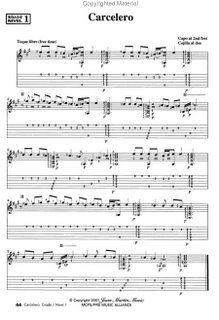
 Flamenco feeds the soul. It is deeply spiritual, mysterious and gut wrenching. Its exact origins are unclear. The music emerged in the southern Andalusian landscape of Spain after traveling out of India with the gypsies. Like the Jews and the Moors, gypsies suffered continual persecution, and lived for centuries in perpetual fear of pogroms and expulsions.
Flamenco feeds the soul. It is deeply spiritual, mysterious and gut wrenching. Its exact origins are unclear. The music emerged in the southern Andalusian landscape of Spain after traveling out of India with the gypsies. Like the Jews and the Moors, gypsies suffered continual persecution, and lived for centuries in perpetual fear of pogroms and expulsions.Rootless and poor, forced into thievery and often imprisoned, like Sister Renata, the gypsies created a music that cries out in anguish and desperation. Whether in dance ("baile"), song ("cante") or guitar ("toque"), the performer of flamenco dives into profound displays of emotion, or “duende,” all the while holding strictly to “compás,” the driving beat of the music, as relentless as a heartbeat or a death march. Lyrics reflect the paradoxical character of the Spanish people, juxtaposing piety and passion, whores and nuns. And those castenats? That rattle is a rattle perhaps of the bones that linger after death!
So I didn’t know a thing about flamenco until a day in January 1995 when I was lying on the floor of my bedroom. And then, something amazing happened. I heard the flamenco playing, and it lit a fury in my chest. For the whole story on how the mysterious music swept me up and how playing flamenco under the direction of virtuoso Maria Zemantauski changed my life, my whole attitude toward art and how it frees the soul, then read the Acknowledgements in my new novel, "Seeing Red." Oh -- and if you would, please buy the book?
So I didn’t know a thing about flamenco until a day in January 1995 when I was lying on the floor of my bedroom. And then, something amazing happened. I heard the flamenco playing, and it lit a fury in my chest. For the whole story on how the mysterious music swept me up and how playing flamenco under the direction of virtuoso Maria Zemantauski changed my life, my whole attitude toward art and how it frees the soul, then read the Acknowledgements in my new novel, "Seeing Red." Oh -- and if you would, please buy the book?
And while you're at it, go to CD Baby, and please buy Maria's music, her amazing CD, "Seeing Red," because you see, it is Maria's music that inspired Castenata and Sister Mysteries and Seeing Red! I wrote the entire novel, Seeing Red, every single chapter, with headphones on, listening to her first CD, "Mrs. Laughinghouse." Those rasqueados and falsetas and arpeggios and the thunderous drumming and strumming that Maria plays on her strings and the body of her guitar they filled me with emotion and words and scenes and characters. And the rest is history, or better, herstory!
In the depths of my cancer treatment, in July, 2002, when the veins in my arms grew so sore from the chemo that I could barely hold up the guitar, I went to my lesson anyway, just because that fucking doctor (Dr. Monster) at Sloan had told me not to, I went because my remarkable guitar teacher Maria Z is so wonderful, so talented and spirited and inspiring. We sat there chatting and after a while Maria said very casually to me, “Hey, why don’t you see if you can just hold the guitar. Don’t put any pressure on your fingers at all. So I took the guitar
 out of its red velvet case, and held it in my lap. I felt happy. And soon she had my fingers on the strings, and my arms didn’t hurt, and I played. I played. I played.
out of its red velvet case, and held it in my lap. I felt happy. And soon she had my fingers on the strings, and my arms didn’t hurt, and I played. I played. I played.And just like me, back in 1883, Renata plays and plays and plays and frees herself from the hellhole of her prison cell!
A CARCELERA is a form of flamenco that specifically refers to prison and jail life. According to The Art of Flamenco, by D.E. Pohren, gypsy prisoners used to sing to relatives and friends outside the prison walls, in the language called caló, the Gypsy language that mixed romaní and Spanish. One such song, and this is a real song taken from Pohren's book, is the song that Renata sings in prison in Chapter 24:
“In three days I’ve eaten
Only bread and tears:
That is the food
That my jailers give.”
A CARCELERA is a form of flamenco that specifically refers to prison and jail life. According to The Art of Flamenco, by D.E. Pohren, gypsy prisoners used to sing to relatives and friends outside the prison walls, in the language called caló, the Gypsy language that mixed romaní and Spanish. One such song, and this is a real song taken from Pohren's book, is the song that Renata sings in prison in Chapter 24:
“In three days I’ve eaten
Only bread and tears:
That is the food
That my jailers give.”
No comments:
Post a Comment